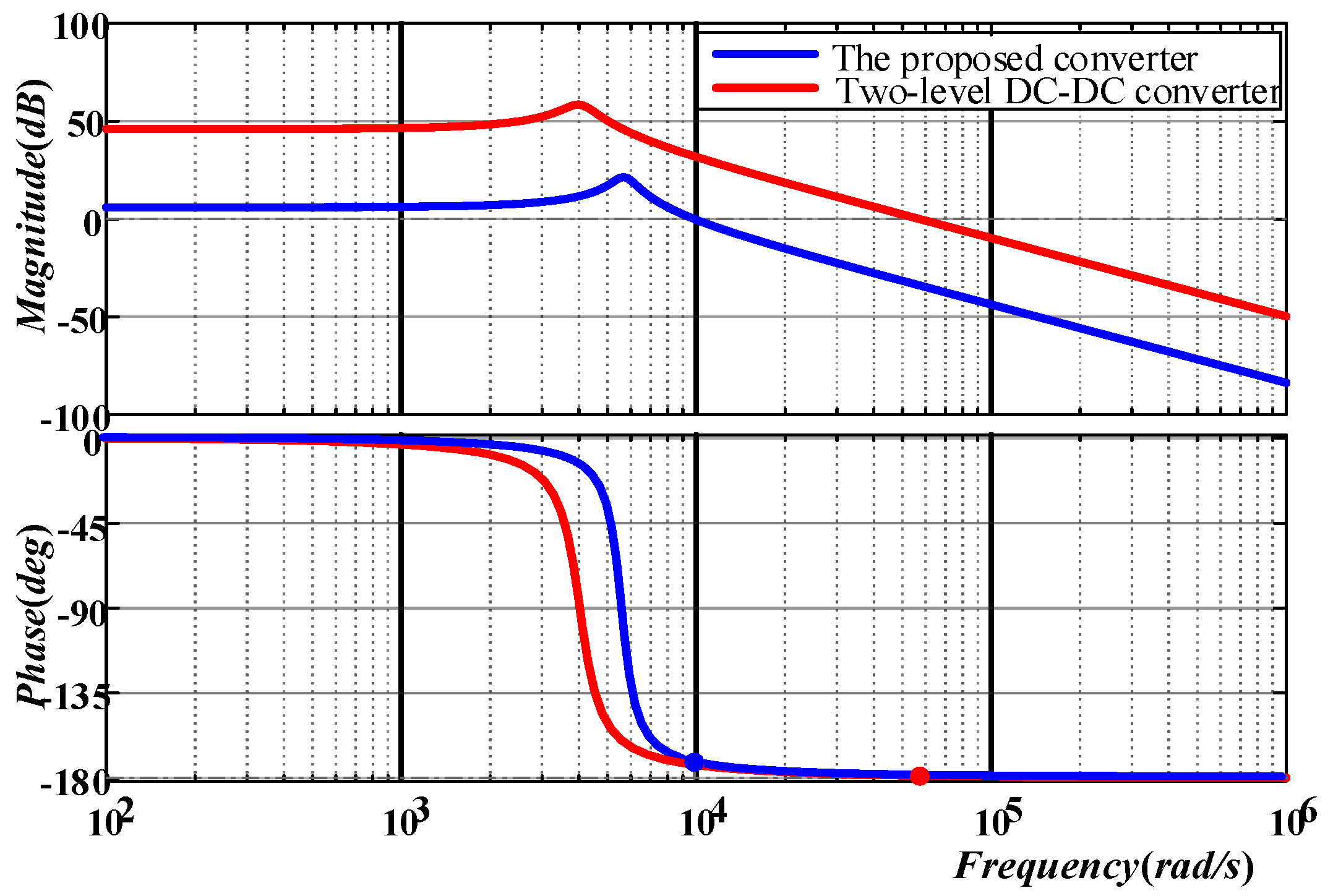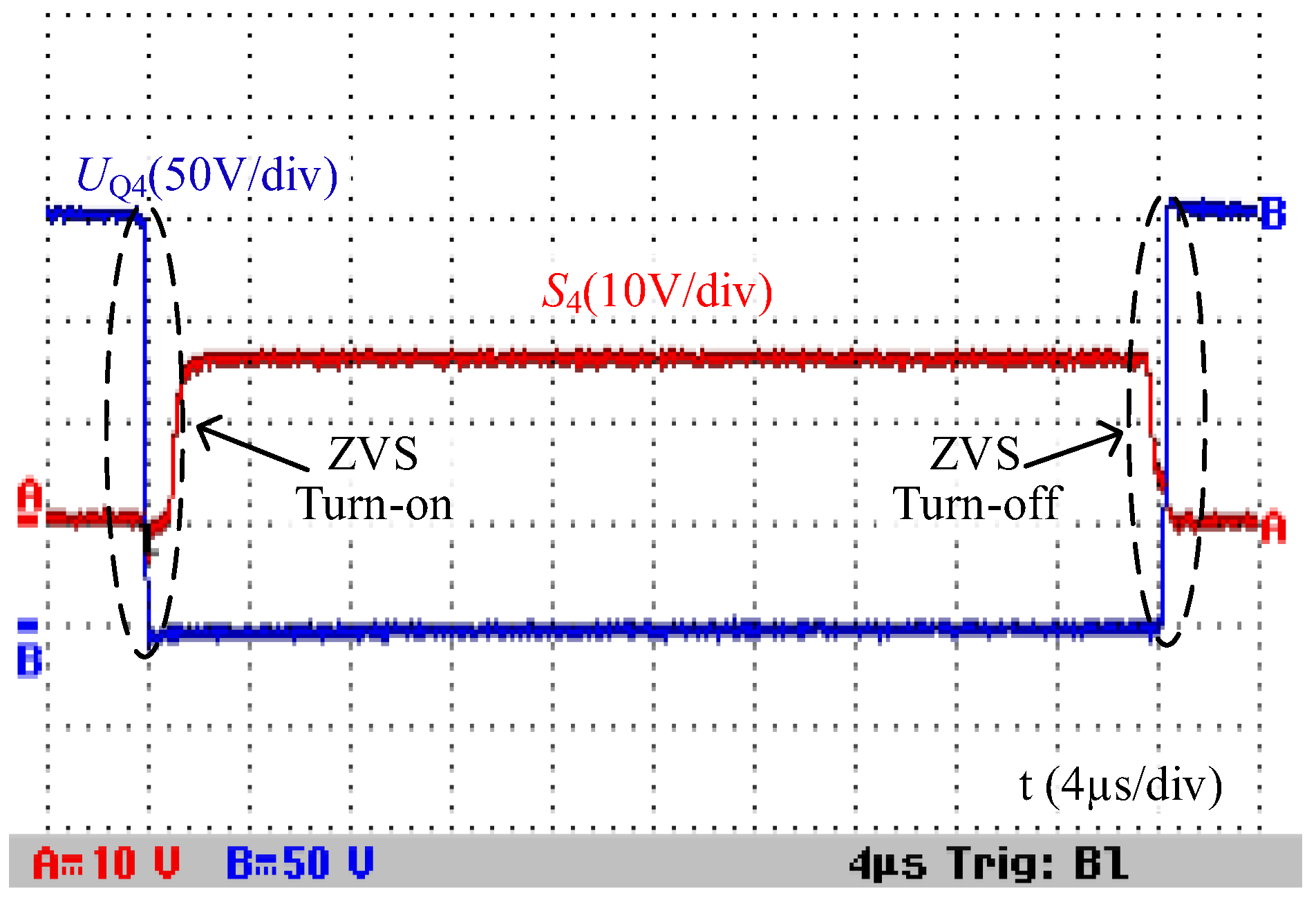Common Grounded H-Type Bidirectional DC-DC Converter with a Wide Voltage Conversion Ratio for a Hybrid Energy Storage System
Abstract
:1. Introduction
2. Operating Principles of the Proposed Converter
2.1. Configuration of the Proposed Converter
2.2. Operating Principles
2.2.1. Step-Up Mode of the Proposed Converter
2.2.2. Step-Down Mode of the Proposed Converter
2.2.3. Synchronous Rectification Mode of the Proposed Converter
2.3. Control Strategy for Bidirectional Power Flow
3. Characteristics of the Proposed Converter
3.1. Wide Voltage Conversion Ratio
3.1.1. Voltage Conversion Ratio in Step-Up Mode
3.1.2. Voltage Conversion Ratio in Step-Down Mode
3.2. Low Inductor Current Ripple
3.2.1. The Average Inductor Current and Inductor Current Ripple in Step-Up Mode
3.2.2. The Average Inductor Current and Inductor Current Ripple in Step-Down Mode
3.3. Good Dynamic Performance
- Avoiding the narrow pulse of PWM voltage waveforms when a high voltage conversion ratio is achieved: It costs a little time to turn a power semiconductor on and off, thus the ideal narrow pulse of the PWM voltage waveform is difficult to realize. The higher the voltage conversion ratio of the proposed converter is, the closer the duty cycle is to 0.5. When the duty cycle approaches 0.5, the time used to maintain the ON and OFF state for all power semiconductors is nearly equal in each period, which is beneficial to avoid the narrow pulse of PWM voltage waveforms while a high voltage conversion ratio is achieved.
- Reducing inductor current ripple: The inductor L is charged and discharged twice during each switching period, as 0 and 0 show. With a small duty cycle in step-up mode, the charging time of the inductor is short. The charging time of the inductor in step-down mode is short too. Then, the inductor current ripple will decrease.
- Good dynamic performance: Due to using small inductance and a higher equivalent switching frequency, the proposed converter has a better dynamic performance.
3.4. Voltage and Current Stress on the Power Switches
4. Experimental Result and Analyses
4.1. Experimental Results in the Step-Up Mode
4.2. Experimental Results in the Step-Down Mode
4.3. Bidirectional Power Flow Experiment
5. Conclusions
Acknowledgments
Author Contributions
Conflicts of Interest
References
- Han, Y.; Chen, W.; Li, Q. Energy Management Strategy Based on Multiple Operating States fora Photovoltaic/Full Cell/Energy Storage DC Microgrid. Energies 2017, 10, 136. [Google Scholar] [CrossRef]
- Whaite, S.; Grainger, B.; Kwasinski, A. Power quality in DC power distribution systems and microgrids. Energies 2015, 8, 4378–4399. [Google Scholar] [CrossRef]
- Yu, X.; She, X.; Zhou, X.; Huang, A.Q. Power management for DC microgrid enabled by solid-state transformer. IEEE Trans. Smart Grid 2014, 5, 954–965. [Google Scholar] [CrossRef]
- Hu, J.; Cheng, K.W.E. Predictive control of power electronics converters in renewable energy systems. Energies 2017, 10, 515. [Google Scholar] [CrossRef]
- Wang, B.; Sechilariu, M.; Locment, F. Intelligent DC microgrid with smart grid communications: Control strategy consideration and design. IEEE Trans. Smart Grid 2012, 3, 2148–2156. [Google Scholar] [CrossRef]
- Liu, F.; Liu, J.; Zhang, H.; Xue, D. Stability issues of Z+Z type cascade system in hybrid energy storage system (HESS). IEEE Trans. Power Electron. 2014, 29, 5846–5859. [Google Scholar] [CrossRef]
- Shim, J.W.; Kim, Y.; Cho, S.-J.; Min, S.W.; Hur, K. Synergistic control of SMES and battery energy storage for enabling dispatchability of renewable energy sources. IEEE Trans. Appl. Supercond. 2013, 23. [Google Scholar] [CrossRef]
- Xie, Q.; Wang, Y.; Kim, Y.; Pedram, M.; Chang, N. Charge allocation in hybrid electrical energy storage systems. IEEE Trans. Comput.-Aided Des. Integr. Circuits Syst. 2013, 32, 1003–1016. [Google Scholar]
- Wang, G.; Ciobotaru, M.; Agelidis, V.G. Power smoothing of large solar PV plant using hybrid energy storage. IEEE Trans. Sustain. Energy 2014, 5, 834–842. [Google Scholar] [CrossRef]
- Chen, X.Y.; Jin, J.X.; Xin, Y.; Shu, B.; Tang, C.L.; Zhu, Y.P.; Sun, R.M. Integrated SMES technology for modern power sys-tem and future smart grid. IEEE Trans. Appl. Supercond. 2014, 24. [Google Scholar] [CrossRef]
- Li, J.; Yang, Q. Design and test of a new droop control algorithm for a SMES/battery hybrid energy storage system. Energy 2017, 118, 1110–1122. [Google Scholar] [CrossRef]
- Xiao, J.; Wang, P.; Setyawan, L. Hierarchical control of hybrid energy storage system in DC microgrids. IEEE Trans. Ind. Electron. 2015, 62, 4915–4924. [Google Scholar] [CrossRef]
- Shen, J.; Khaligh, A. A supervisory energy management control strategy for a battery/ultracapacitor hybrid energy storage system. IEEE Trans. Transp. Electr. 2015, 1, 223–231. [Google Scholar] [CrossRef]
- Li, J.; Tang, Y.; Shi, J.; Gong, K.; Liu, Y.; Ren, L.; Li, J. Design and advanced control strategies of a hybrid energy storage system for the grid integration of wind power generations. IET Renew. Power Gener. 2015, 9, 89–98. [Google Scholar]
- Choi, M.-E.; Kim, S.-W.; Seo, S.-W. Energy management optimization in a battery/supercapacitor hybrid energy storage system. IEEE Trans. Smart Grid 2012, 3, 463–472. [Google Scholar] [CrossRef]
- Zhang, Y.; Jiang, Z.; Yu, X. Control strategies for battery/supercapacitor hybrid energy storage systems. In Proceedings of the 2008 IEEE Energy 2030 Conference, Atlanta, GA, USA, 17–18 November 2008; pp. 1–6. [Google Scholar]
- Inoue, S.; Akagi, H. A bidirectional dc-dc converter for an energy storage system with galvanic isolation. IEEE Trans. Power Electron. 2007, 22, 2299–2306. [Google Scholar] [CrossRef]
- Wu, K.; De Silva, C.W.; Dunford, W.G. Stability Analysis of Isolated Bidirectional Dual Active Full-Bridge DC–DC Converter with Triple Phase-Shift Control. IEEE Trans. Power Electron. 2012, 27, 2007–2017. [Google Scholar] [CrossRef]
- Li, W.; Wu, H.; Yu, H.; He, X. Isolated winding-coupled bidirectional ZVS converter with PWM plus phase shift (PPS) control strategy. IEEE Trans. Power Electron. 2011, 26, 3560–3570. [Google Scholar] [CrossRef]
- Xuewei, P.; Rathore, A.K. Novel bidirectional snubberless naturally commutated soft-switching current-fed full bridge isolated DC/DC converter for fuel cell vehicles. IEEE Trans. Ind. Electron. 2014, 61, 2307–2315. [Google Scholar] [CrossRef]
- Wai, R.J.; Wang, W.H.; Lin, C.Y. High-performance stand-alone photovoltaic generation system. IEEE Trans. Ind. Electron. 2008, 55, 240–250. [Google Scholar] [CrossRef]
- Wai, R.J.; Wang, W.H. Grid-connected photovoltaic generation system. IEEE Trans. Circuits Syst. I Regul. Pap. 2008, 55, 953–964. [Google Scholar]
- Forouzesh, M.; Siwakoti, Y.P.; Gorji, S.A.; Blaabjerg, F.; Lehman, B. Step-Up DC–DC Converters: A Comprehensive Review of Voltage Boosting Techniques, Topologies, and Applications. IEEE Trans. Power Electron. 2017, 32, 9143–9178. [Google Scholar] [CrossRef]
- Ajami, A.; Ardi, H.; Farakhor, A. A novel high step-up DC/DC converter based on integrating coupled inductor and switched-capacitor techniques for renewable energy applications. IEEE Trans. Power Electron. 2015, 30, 4255–4263. [Google Scholar] [CrossRef]
- Shen, H.; Zhang, B.; Qiu, D.; Zhou, L. A common grounded Z-source DC–DC converter with high voltage gain. IEEE Trans. Ind. Electron. 2016, 63, 2925–2935. [Google Scholar] [CrossRef]
- Zhang, G.; Li, Z.; Zhang, B.; Qiu, D.; Xiao, W.; Halang, W.A. A Z-source half-bridge converter. IEEE Trans. Ind. Electron. 2014, 61, 1269–1279. [Google Scholar] [CrossRef]
- Takiguchi, T.; Koizumi, H. Quasi-Z-source dc-dc converter with voltage-lift technique. In Proceedings of the 39th Annual Conference of the IEEE Industrial Electronics Society, IECON 2013, Vienna, Austria, 10–13 November 2013; pp. 1191–1196. [Google Scholar]
- Tang, Y.; Wang, T.; He, Y. A switched-capacitor-based active-network converter with high voltage gain. IEEE Trans. Power Electron. 2014, 29, 2959–2968. [Google Scholar] [CrossRef]
- Tang, Y.; Fu, D.; Wang, T.; Xu, Z. Hybrid switched-inductor converters for high step-up conversion. IEEE Trans. Ind. Electron. 2015, 62, 1480–1490. [Google Scholar] [CrossRef]
- Tang, Y.; Wang, T.; Fu, D. Multicell switched-inductor/switched-capacitor combined active-network converters. IEEE Trans. Power Electron. 2015, 30, 2063–2072. [Google Scholar] [CrossRef]
- Ardi, H.; Ajami, A.; Kardan, F.; Avilagh, S.N. Analysis and implementation of a no-isolated bidirectional DC–DC converter with high voltage gain. IEEE Trans. Power Electron. 2016, 63, 4878–4888. [Google Scholar] [CrossRef]
- Zhang, Y.; Liu, Q.; Li, J.; Sumner, M. A Common Ground Switched-Quasi-Z-Source Bidirectional DC-DC Converter with Wide-Voltage-Gain Range for EVs with Hybrid Energy Sources. IEEE Trans. Ind. Electron. 2017, PP. [Google Scholar] [CrossRef]
- Zhou, X.; Donati, M.; Amoroso, L. Improved light-load efficiency for synchronous rectifier voltage regulator module. IEEE Trans. Power Electron. 2000, 15, 826–834. [Google Scholar] [CrossRef]
- Wang, J.; Wu, S. A Novel Control Scheme of Synchronous Buck Converter for ZVS in Light-Load Condition. IEEE Trans. Power Electron. 2011, 26, 3265–3273. [Google Scholar] [CrossRef]
- Zhang, Y.; Li, Y. Energy Management Strategy for Supercapacitor in Droop-Controlled DC Microgrid Using Virtual Impedance. IEEE Trans. Power Electron. 2017, 32, 2704–2716. [Google Scholar] [CrossRef]
- Xu, Q.; Hu, X.; Wang, P.; Xiao, J.; Tu, P.; Wen, C.; Lee, M.Y. A Decentralized Dynamic Power Sharing Strategy for Hybrid Energy Storage System in Autonomous DC Microgrid. IEEE Trans. Ind. Electron. 2017, 64, 5930–5941. [Google Scholar] [CrossRef]























| Parameters | Values |
|---|---|
| Rated power Pn | 320 W |
| Storage/filter capacitor Clow and Chigh | 260 uF |
| Clamp capacitor C1 | 260 uF |
| Storage/filter inductor L | 114 uH |
| High-voltage side Uhigh | 200 V |
| Low-voltage side Ulow | 25~60 V |
| Switching frequency f | 20 kHz |
| Power semiconductors Q1–Q5 | IXTH 88N30P |
© 2018 by the authors. Licensee MDPI, Basel, Switzerland. This article is an open access article distributed under the terms and conditions of the Creative Commons Attribution (CC BY) license (http://creativecommons.org/licenses/by/4.0/).
Share and Cite
Bi, H.; Wang, P.; Wang, Z. Common Grounded H-Type Bidirectional DC-DC Converter with a Wide Voltage Conversion Ratio for a Hybrid Energy Storage System. Energies 2018, 11, 349. https://doi.org/10.3390/en11020349
Bi H, Wang P, Wang Z. Common Grounded H-Type Bidirectional DC-DC Converter with a Wide Voltage Conversion Ratio for a Hybrid Energy Storage System. Energies. 2018; 11(2):349. https://doi.org/10.3390/en11020349
Chicago/Turabian StyleBi, Huakun, Ping Wang, and Zhishuang Wang. 2018. "Common Grounded H-Type Bidirectional DC-DC Converter with a Wide Voltage Conversion Ratio for a Hybrid Energy Storage System" Energies 11, no. 2: 349. https://doi.org/10.3390/en11020349





